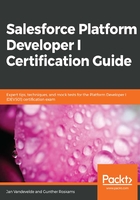
上QQ阅读APP看书,第一时间看更新
Accounts
Accounts are orgs or individuals (when Person Accounts is enabled) that are involved with your business in some way (such as the customer, competitor, partner, or supplier).
There are two types of accounts, as follows:
- Business accounts (B2B): This is the default account type. An account usually contains the general information about a company, such as the name, billing address, shipping address, sector, segment, and VAT number. They also contain several related lists of records, such as the people who work there, the cases that are logged, the opportunities that are sent, the documents that are uploaded, and more.
- Person accounts (B2C): If your company also deals with individuals, not companies, you can ask Salesforce to enable Person Accounts in your org. However, be aware that once this feature has been enabled, it cannot be disabled (but you can still choose not to use the record type). Person Accounts are a combination of the account object and the contact object. They mostly contain user information, such as first name, last name, date of birth, gender, hobbies, interests, and more.
Of course, if your company deals in both B2B and B2C, then you can use both business accounts and Person Accounts in your org.
The account object also comes with some specific features, as follows:
- Account hierarchies: The account object has a standard lookup field called the parent account. When this is filled in, it creates a hierarchical relationship between the accounts. When clicking on View Account Hierarchy from an account, you can see the whole account relationship from the point of view of the current record. You can easily navigate from one account to the other within the hierarchy. An admin can also modify or adjust up to 15 columns, shown on the Hierarchy overview page, through Setup | Object Manager | Account | Hierarchy Columns. The following screenshot shows how Account Hierarchy is presented to the user on the Salesforce interface:

The Account Hierarchy is most commonly used in the following way:

- Account teams: These are another way in which to grant access to a specific account record, next to Organisation-Wide Defaults (OWD), sharing rules, and manual sharing. Here, the owner of an account can specify other users (called Account Team Members) working on that same account with a specific business role (such as inside sales, support representatives, and project managers) and specific privileges (read-only or read-write). The user is also able to specify a default account team for each user, which will automatically be added onto the account where that user is the owner of the account. The account teams feature is disabled by default; you can enable it by going to Setup | Feature Settings | Sales | Account Teams.